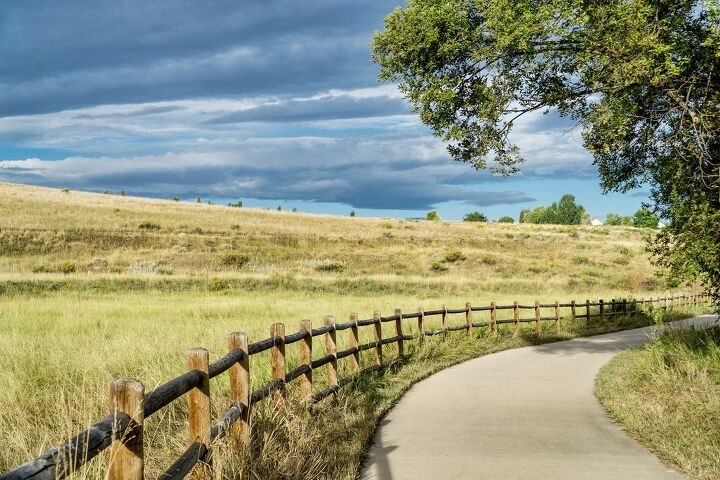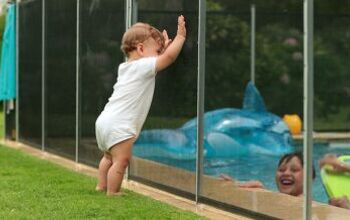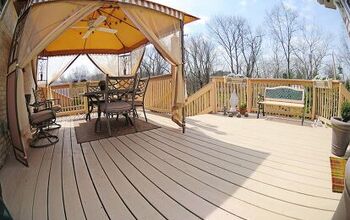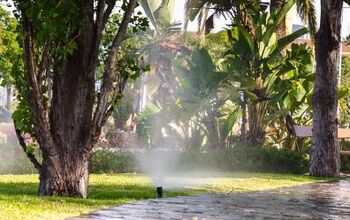How Much Does A Split Rail Fence Cost?

A fence is an extension of the home, and many builder-owners carefully choose the best fit for their own house. One of the most timeless and attractive options is the split rail fence, and it is the choice of many homeowners. Some builder-owners want split rail fences for the visual, and others want them for practical reasons, but what do they cost?
A split rail fence costs between $1,500 and $10,000 including materials, labor, and installation. The total cost is determined by the size of the space you are enclosing with the fence. You should expect to pay between $10 and 20 or more per linear foot in materials alone without labor.
Split rail fences are popular for both agricultural and visual reasons, and it is a great fencing option. Let’s take a look at what you should expect to pay for your split rail fence, and what matters most.
Do You Need Fence Installation or Repair Services?
Get free, zero-commitment quotes from pro contractors near you.

What Is a Split Rail Fence?
A split rail fence is a wooden fence that usually has two or three rails. Many people associate split rail fences with agricultural and livestock work. The wood in split rail fences is durable and resistant to rotting.
You don’t only find split rail fences on farms, however, and they are a great choice for any home. Not all split rail fences are made of wood, and there are many options. The most popular types of split rail fences are pine, cedar, composite, metal, and vinyl.
How Much Does A Split Rail Fence Cost Per Foot?
| Split Rail Fence Materials | Material Cost Per Foot | Cost Per 100 Feet |
| Pine | $10-$14 | $1,000-$1,400 |
| Cedar | $10-$14 | $1,000-$1,400 |
| Composite | $10-$20+ | $1,000-$2,000 |
| Metal | $17-$25 (steel) $20-$30 (aluminum) | $1,700-$2,500 (steel) $2,000-$3,000 (aluminum) |
| Vinyl | $10-$20+ | $1,000-$2,000 |
For materials alone, split rail fences can cost as little as $5-$10 per linear foot. However, high-end composite or aluminum can cost between $20 and $30 per linear foot before installation. Each type of split rail fence material is unique and has a different cost per foot.
If you have a large area to enclose and you are trying to budget, it’s important to know the cost per foot. Materials like pine and cedar are great options if you have a large space to enclose due to affordability. You can still use metal or composite split rail fences for large areas, but it will cost you greatly.
Split Rail Fence Materials
Each type of material for split rail fences is unique in style, character, and cost. The material that you choose is about more than just appearance, and each one has its own strengths. Let’s see how choosing the right material affects how much your split rail fence costs.
Pine Split Rail Fence
Pine is a sturdy wood, and yellow pine specifically is great for split rail fences. You usually pay between $10 and $14 per linear foot for pine, and $15-$30 for it including the installation.
Some builder-owners choose pine because it can last between 10 and 25 years under the right conditions. Try to choose pressure-treated pine if possible, and it will hold up to the elements that much better.
There are optional additional costs, such as painting, and that costs $4-$8 per linear foot. Painting your pine split rail can add up to $800 to the bill.
Cedar Split Rail Fence
Another excellent wood option is the classic and iconic cedar split rail fence. Cedar is a long-lasting, durable, and attractive wood that many builder-owners choose for longevity. Depending on the cut of the wood, some cedar split rail fences can last up to 30 years.
Just like pine, cedar split rail fences cost roughly $1,000-$1,400 in materials for 100 linear feet. You don’t need to get cedar specially treated for it to resist rotting, and it has its own natural resistance.
Cedar is not quite as durable as pine, but it is still a great option. Look for Western Red Cedar because it is strong, light, decay-resistant, and looks great.
Composite Split Rail Fence
Composite fencing gets more and more popular every year. One of the reasons that composite split rail fences are so sought after is that they are light and can last 20 years. There is a wide range in cost for composite fencing, and it can cost up to $20 per linear foot.
Unlike pure wood, there is no chance for composite fencing decaying and rotting. That is because it is generally made up of a mixture of plastic and resin. Sometimes, there are small pieces of wood in composite split rail fences, but it is still rot-resistant.
Metal Split Rail Fence
You can choose between aluminum and steel split rail fences. Steel is cheaper than aluminum by $3-$5 per linear foot, but it is actually stronger than aluminum. There is a powder coating on aluminum that makes it resistant to rust, and it is a sturdy choice as well.
You can’t go wrong with either aluminum or steel, and it is ultimately a matter of taste. However, if you want to leave a small carbon footprint, you may want aluminum. You can recycle aluminum once it is time for a new fence, and that is one of its many appeals.
Luckily, both steel and aluminum fences have a long lifespan. You can expect a steel split rail fence to last as long as 70 years. Aluminum is durable as well and lasts at least 25-30 years but can last much longer.
Vinyl Split Rail Fence
Vinyl is another material with many options that range in cost and quality. You get what you pay for with vinyl fencing, and options start as low as $10 per foot. There is consumer-grade vinyl, which costs closer to $10 per foot, and professional-grade vinyl, which costs closer to $20 per linear foot.
One downside to vinyl is that it costs more than wood, but it makes up for it with longevity. You can easily get 20 years or more out of a vinyl split rail fence. They are also low maintenance, especially compared to wood, and vinyl has no chance for decay.
It costs up to $35 per linear foot to install a vinyl split rail fence with labor and materials included. Many builder-owners find the added material cost worth it when they don’t have to treat and replace their fence.
A-Frame Split Rail Fence Cost
An A-frame split rail fence, or a buck and rail fence, is another popular option that is often made of wood. It is not quite unique in material, but A-frame split rail fences are unique in design. They use slightly more material because they use a frame that posts into the ground.
Some land is not stable enough for regular posts, so A-frames are used instead. An A-frame split rail fence costs $3-$5 per linear foot for materials.
Cost To Install Split Rail Fence
There are several installation costs beyond the materials for a split rail fence. Installation costs can vary based on many factors, but the most important ones to consider include:
- Labor
- Supplies and equipment
- How many rails you choose
- Yard and property conditions
Each one of the above factors is important and dictates the cost.
Split Rail Fence Labor Cost
Labor gets expensive no matter what the installation is, and fences are no exception. Split rail fences are not that difficult to install, but it is still labor-intensive. It costs between $400 and $1,000 in labor to install a 100 linear foot split rail fence.
You should get a quote from several different contractors and compare labor and installation costs. Installation is fairly easy due to the simple design of split rail fences, and it only takes 1-4 days.
Number Of Rails
Exactly how many rails you want in your split rail fence affects the cost as well. If you want a 100 linear foot fence with only 2 rails, you’d spend between $200 and $800 in materials. However, if you wanted 5 rails for the same size fence, it would cost between $500 and $2,000.
The classic split rail fence is the 2 or 3 rail fence, but some builder-owners go as high as 5. You can find rails for $1-$5 per foot, and they come in all shapes and sizes. There are flat and round rails, and round is your best option for longevity.
You can also go for flat rails, and they create a classic rustic farmhouse look. Whether you choose round or flat rails does not ultimately affect the cost of your split rail fence.
Split Rail Fence Location
Where are you putting your split rail fence? There is no direct tie between where you put it and cost, but it is incredibly important. Installation can be tricky if you have hard soil, clay, steep inclines, or slope in the area, and that adds to labor costs.
If your contractor runs into patches of clay or tough soil, they may spend more time preparing. That adds to installation costs and can take longer. Location can also add to supply and material costs if the poor soil in that spot requires more gravel.
You may be limited to the size of your property, and you’ll have to make use of what you have. If all that you have is tough soil, that is okay, but expect it to be reflected in costs. The most expensive location for a split rail fence is anywhere that has clay beneath the soil.
Split Rail Fence Supplies
Another cost factor that goes hand in hand with labor and location is supplies. Supplies only make up a small part of the total cost, but every bit matters. It is rare to spend more than $50 on supplies in your split rail fence installation bill.
Supplies are sometimes just included with labor, however, but it is often a separate charge. The supplies include concrete, fasteners, and tools. Some contractors include supplies with the equipment charge, which costs between $50 and $100.
Equipment charges can sometimes cost over $100 depending on the contractor and includes concrete mixers and saws.
Related Questions
How do you maintain a split rail fence?
You can maintain a split rail fence by pressure-treating it, staining it, and applying Fence Armor. One way to avoid maintenance entirely is by choosing vinyl or composite fencing. Another way to get around maintenance is to buy pressure treated wood from the beginning.
Should split rail fence posts be set in concrete?
They can be set in concrete, but it is not always a great idea. Post concrete works well, but sometimes it can also weaken the post sooner than it would have. It all comes down to soil quality, how well it drains, and whether or not water ever sits in the hole for extended time.
Will split rail fence keep deer out?
Yes, a split rail fence is a great option for keeping deer out. In fact, many builder-owners consider it to be the best option. If the split rail fence is below 5 feet tall, the deer may be able to jump it and get into your yard either way.
How high is a split rail fence?
Split rail fences vary in height but are usually between 3 and 4 feet tall. Sometimes, builder-owners choose to go higher, particularly if they are fencing in and keeping out animals. Fences with 4 or 5 rails need to be at least 4 feet tall.
Can you paint a split rail fence?
Yes, you can paint a split rail fence, and it is in fact quite popular. Just like anything, you must prime and prepare a split rail fence before you can paint it. It costs between $4 and $8 per linear foot to paint a wooden split rail fence, and $8-$12 per linear foot to paint a metal split rail fence.
Do You Need Fence Installation or Repair Services?
Get free, zero-commitment quotes from pro contractors near you.

What Did We Learn?
It can cost between $1,500 and $10,000 to install a split rail fence. The majority of the cost in materials, which makes up at least $1,000-$2,000 of the total cost. The rest of the cost is made up of labor, which would be between $400 and $1,000 for a 100 linear foot split rail fence.
Materials typically only cost $10-$20 per linear foot, so the contractor that you choose for installation is everything. Split rail fences look great, are practical, and are affordable. Call a contractor and see how much your own split rail fence will cost.

Nick Durante is a professional writer with a primary focus on home improvement. When he is not writing about home improvement or taking on projects around the house, he likes to read and create art. He is always looking towards the newest trends in home improvement.
More by Nick Durante










![How Much Does A Vinyl Fence Cost? [Pricing Per Linear Foot]](https://cdn-fastly.upgradedhome.com/media/2023/07/31/9077200/how-much-does-a-vinyl-fence-cost-pricing-per-linear-foot.jpg?size=350x220)















